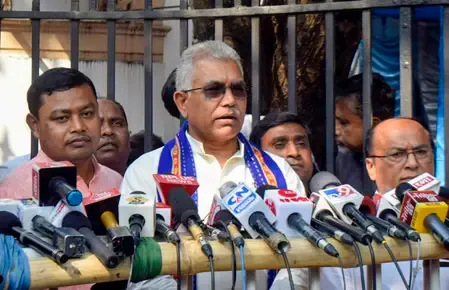From Gir to Global: Gujarat’s Kesar Mangoes Transforming India’s Mango Trade

Synopsis
Key Takeaways
- Gujarat's Kesar mango exports hit 689.5 metric tonnes in 2023-24.
- The fruit is renowned for its saffron-like color and sweetness.
- Gujarat has over 177,514 hectares of mango orchards.
- The state produced 1.08 million metric tonnes of mangoes in 2024.
- Export facilities ensure compliance with international standards.
Ahmedabad, April 4 (NationPress) Gujarat’s mango sector is making significant strides on the global stage, with export volumes of the renowned Kesar mango hitting 689.5 metric tonnes for the year 2023-24.
This mango is distinguished by its distinctive aroma, saffron-hued pulp, and delightful sweetness, making it one of India’s most coveted fruits in both local and international markets. Mango cultivation in Gujarat has a rich history, but it was in 1931 that the Kesar mango was first brought to life in Junagadh’s Gir region.
The name derives from the saffron-like color of its flesh, with the then Nawab of Junagadh famously dubbing it “Kesar” (saffron) due to its vibrant orange shade. Presently, Gujarat boasts over 177,514 hectares of mango orchards, encompassing districts like Valsad, Navsari, Gir-Somnath, Surat, and Kachchh. The state achieved a production of 1.08 million metric tonnes of mangoes in 2024, marking a steady increase from 960,000 metric tonnes in 2023, as per the Horticulture Department of Gujarat. Specialists assert that the state's climate and soil composition are vital in determining the quality of its mangoes.
Gujarat’s sandy loam and black cotton soil, combined with hot, dry summers and moderate rainfall, create optimal conditions for mango trees. Unlike the Alphonso mango, which flourishes in coastal areas, the Kesar mango’s ability to withstand arid conditions makes it perfectly adapted to Gujarat’s ecosystem. 'The elevated temperatures and nutrient-rich soil enhance the natural sugars in the mango, resulting in a sweeter and more flavorful fruit,' remarked Dr. Ramesh Patel, an agricultural scientist from Junagadh Agricultural University. Mango farming is a significant contributor to Gujarat’s agricultural economy.
In 2021, the mango sector in the state generated over Rs 17 billion in revenue, with ongoing growth in both production and exports. Despite facing challenges such as climate variability and pest infestations, mango farmers in Gujarat have evolved by employing advanced agricultural techniques like drip irrigation, organic composting, and grafting to enhance yield and quality.
As the largest mango producer globally, India owes a great deal of its success to Gujarat. In the last five years, the state has exported over 2,500 metric tonnes of mangoes, with the UK, US, and Canada emerging as top markets. To comply with international quality standards, the Gujarat Agro Radiation Processing Facility in Bavla, Ahmedabad, ensures that exported mangoes undergo appropriate treatment. The facility has treated and certified over 210 metric tonnes of Kesar mangoes in the past two years, facilitating seamless shipments to countries with stringent import regulations.
‘Our mangoes are in high demand in Europe and North America. With enhanced cold storage and export infrastructure, Gujarat has the potential to boost its share in global mango exports,’ stated Prakash Mehta, an exporter based in Ahmedabad.
While Gujarat’s mango industry flourishes, it is not without its hurdles, such as climate change, unpredictable monsoons, and market fluctuations. The state government is actively pursuing initiatives like subsidized irrigation, improved logistics, and scientific research to bolster mango production.
Furthermore, partnerships with the Indian Council of Agricultural Research (ICAR) and Gujarat Agricultural Universities aim to develop disease-resistant and climate-adaptive mango varieties. As the peak summer season approaches, Gujarat’s mango orchards are preparing for another prosperous harvest. With rising global demand and a rich historical legacy, Kesar mangoes from Gujarat continue to be a golden fruit—both in flavor and economic significance.










